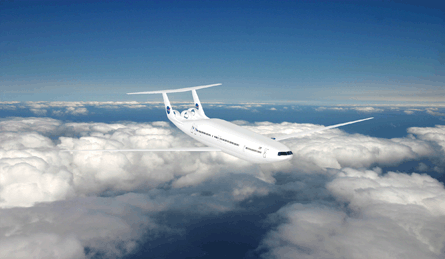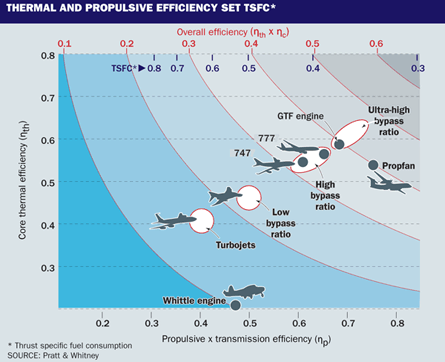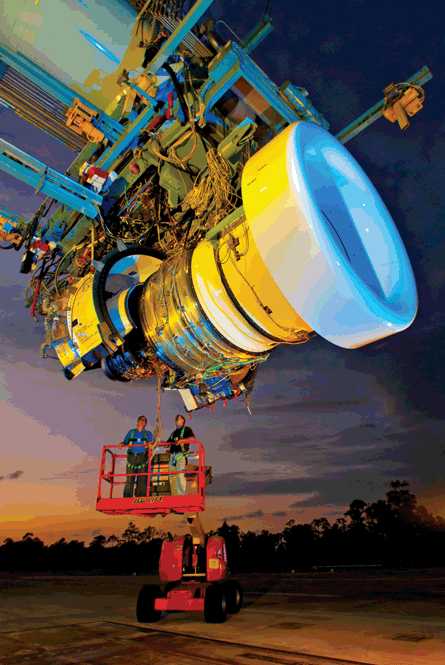Pratt & Whitney engineers are already procuring test equipment for the manufacturer's 2025-targeted next-generation geared turbofan - an engine that must be 15% more fuel efficient than this decade's advanced turbofans for narrowbody airliners, in turn designed to be 15% more fuel efficient than today's powerplants.
Meanwhile, GE's Advanced engineering, technology and preliminary design group, working with NASA and the Federal Aviation Administration, is beginning high-speed windtunnel testing of new blade designs for the company's favoured next-generation civil engine: an unducted fan better known as the open rotor engine.
At the same time, the company's work with military organisations is advancing the state of the art in compressor, combustor and turbine technologies.
 |
|---|
© NASA/Aurora Flight SciencesP&W's work on its Generation 3 is pushing the boundaries of propulsive efficiencies |
"It's the most exciting time in propulsion in the last 40 years, despite economic turmoil of late," says GE's executive for advanced engine systems, Dale Carlson. "The portfolio is rich with demonstrators and technologies. We're blazing a path for the future."
Although both companies are mining technologies that will boost thermal and propulsive efficiencies to reach the long-term goals, P&W tends to trumpet propulsive efficiency gains while GE's focus is on thermal efficiency advances. A milestone for P&W's Generation 2 engine is the planned ground testing of the first prototype in 2014, to be followed by flight tests on the company's Mirabel-based Boeing 747SP testbed.
"We think we're so successful on the [PW1000G geared turbofan] in terms of market penetration because it was real in terms of demonstrations," says P&W vice-president of technology and environment Alan Epstein. "The company is putting resources into that for the next generation."
Progress toward that date has become more tangible, as P&W has ordered parts for a second fan drive gear system test facility - a companion site to one that exists for the PurePower GTF engines at the company's Middletown, Connecticut engine production facility. The location of the new facility has not yet been determined. Details of the architecture of the next engine are beginning to emerge, including a bypass ratio of 15-20:1 compared with about 12:1 for the Bombardier CSeries PW1524G, subsonic fan flow as opposed to the 1524G's low supersonic flow, a planetary fan drive gear system as opposed to the 1524G's fixed star gear arrangement, and a less conservative variable area nozzle for the nacelle. The work is being funded in part through the FAA's continuous lower energy, emissions and noise technology development programme, which aims to develop aircraft that burn 33% less fuel and emit significantly lower noise and emissions.
 |
|---|
GE, as part of that programme, has begun high-speed windtunnel tests of a variety of new fan blade designs for its 2025 open rotor engine, after recently completing low-speed tests as part of a NASA programme.
Major challenges to reaping the 25% reduction in fuel burn that a contra-rotating open rotor pusher engine would provide include lowering the noise to acceptable levels and developing a highly reliable pitch change mechanism for the blades. "The team has come up with innovative notions for pitch change mechanisms," says Carlson. "It shows great promise for reducing the complexity."
Despite the promise of open rotor from a physics standpoint, GE is readying alternate plans in case airframers choose a different path. "It's not just the open rotor configuration we're investigating," says Carlson. "It depends on what the marketplace decides. You can't put all your eggs in one tech basket."
SHARED RESOURCES
Research into a new design is unlikely to be wasted even if that particular configuration falls out of favour. "The process is to design a 2025 engine and a 2035 engine, seeing what technologies we need and seeing how those can be campaigned into current and legacy products," says Epstein of the P&W's Generation 2 and 3 work which began about three years ago. "We have the A-team on it, part-time." "Part-time" because the company's success in selling its Generation 1 "PurePower" geared turbofan engines to the likes of Airbus for the A320neo twinjet, Bombardier for the CSeries airliner, Mitsubishi for the MRJ regional jet and others has meant engineering resources must be shared.
"It's like filling a glass with a leak," Epstein says of the battle to keep advanced development staffed.
The engineers are pushing the boundaries of propulsive and thermal efficiencies to make the needed jumps in overall engine efficiency. The Generation 1 engine already boosts both the thermal and propulsive efficiencies compared with today's most efficient engines - the large high-bypass engines such as the GE90 or PW4000 for widebody aircraft like the Boeing 777. Future generations will continue the trend, with Generation 3 engines to be 15% more fuel efficient than Generation 2.
"I can see us growing unconstrained to 2035," says Epstein. Thermal efficiency - how well an engine converts its fuel to mechanical energy - tops out at about 55% conversion efficiency in today's engines, says Epstein, but theoretically can be pushed as high as 82%.
"Higher" usually means running the core hotter, which, to be efficient, will require new materials in the compressor and high-pressure turbine rather than additional cooling air from the fan.
"Nickel's about out of oomph after 60 years," says Epstein. "Most of the benefit over the past few decades has been in casting technologies and thermal barrier coatings."
Options P&W and other engine manufacturers are looking into include ceramic matrix composites, titanium alumide and, potentially, nanomaterials like carbon nanotube-reinforced polymers.
 |
|---|
© Pratt & WhitneyIn P&W's PurePower engines a gear system drives the fan |
"The big disadvantage is cost and risk for the exotic materials," says Epstein. "Cost is not a risk to the customer until they have to buy a replacement." GE has heavily invested in pushing thermal boundaries with new materials and techniques.
"If you look at what differentiates [the] GE product line, the number one thing to build a great engine is the high spool," says Carlson. "Thermal efficiency begins in the core."
By 2035, a GE commercial aircraft engine could be 50% non-metallic, says Carlson. Last year the company successfully tested a lightweight CMC turbine blade in an F404 engine, the "first time in the history of turbines that a non-metallic has run successfully in the hot section", he recalls. Later this year, GE will test a new high-compression-ratio compressor on a test rig as part of the Air Force Research Laboratory's highly efficient embedded engine technology (Heete) programme.
While today's best compressors have a 23-25:1 pressure ratio, the Heete target for this summer is a "30:1 class for potential notional products", says Carlson.
Propulsive efficiency - how well an engine coverts mechanical energy in the shaft to fan thrust - today tops out at less than 70% for the best widebody turbofans, a number P&W pushes up to around 70% for the first-generation PurePower narrowbody engine.
The P&W boost in propulsive efficiency that yields a 6% decrease in fuel burn is primarily due to the gear system. PurePower engines use a gearing arrangement whereby the low spool (the shaft connecting the low-pressure turbine and low-pressure compressor) is connected to a sun gear surrounded by captive star gears spinning on oil-lubricated journal bearings just behind the fan.
Outside the star gears is a ring gear that drives the fan, an arrangement that provides a roughly 3:1 gear ratio and allows the fan to spin about 30% more slowly than traditional non-geared engines while allowing the low spool to spin about twice as fast, meaning about four fewer low-pressure turbine stages, or 1,500 fewer aerofoils.
NEXT GENERATION
Even considering the added weight of the fan drive gear system - about 125kg (275lb) - the weight savings from the reduction in aerofoils amounts to about 182kg per engine.
For the Generation 2 fan drive gear system, the star gears will be free to rotate, captured on the outside by a ring gear connected to the fan, and on the inside by the sun gear.
The planetary gear arrangement allows for a higher gear ratio for the same size fan drive gear systems, a needed modification given that the fan size must increase for the higher bypass ratio, and associated increased propulsive efficiency.
Bob Saia, P&W vice-president, next-generation product family, says 2% of the fuel-burn decrease comes from the larger fan and higher bypass ratio (about 11-12:1 for the Bombardier CSeries' PW1524G); 2% comes from having a shorter, faster, lighter low-pressure turbine; and 2% comes from having a variable area nozzle in the nacelle.
While turbofans typically use a relatively simple fixed exit nacelle, the physics of the GTF's slow-turning, large-bypass fan require the nacelle's exit to be relatively large for take-off and reverse-thrust operations to ensure that back-pressure does not subject the fan to potential flutter conditions. The same large-area nozzle needed to meet the high-power flutter margin criteria, however, is inefficient for the reduced power operations at cruise, where a narrower nozzle is desired to slow the flow through the engine for optimal fan performance, hence best fuel burn.
To optimise engine performance across the operating range, P&W and nacelle builder Goodrich developed a variable area nozzle with linear actuators that vary the exit area as commanded by each engine's digital controller. In the "open" or widest position, the nozzle protects against fan resonance, or flutter, on take-off and reverse-thrust operations.
In the closed position in cruise flight, the nozzle will provide the 2% reduction in fuel consumption. The controller will automatically adjust the nozzle for optimal engine performance, whether it be for fuel economy or noise, in other flight regimes as well.
CRANKED UP
Innovations in the Generation 1 engine will be cranked up to meet next-generation mandates. While Generation 1 engines have a bypass ratio in the 10-12:1 region, about twice the bypass ratio of CFM56 engines; Generation 2 will feature bypass ratios of 15-20:1 with subsonic fan flows to minimise noise.
"The constraint is that the engine has to fit," says Epstein, noting that P&W and Airbus were able to come up with a way to incorporate a 203cm (80in) diameter fan under the wing for the A320neo. "It's a much bigger fan than people thought you could do." For next-generation aircraft, a 15-18 bypass ratio can fit under a low-wing aircraft "but that doesn't mean it's optimal", says Epstein.
Things really get interesting after 2025. "Tube and wing will get you through the mid-2020s and will accommodate the best engine you know you can build, with a 15 or 18-20 BPR [bypass ratio]," says Epstein. "Once you get bigger than that, it's not going to fit... You have two choices, to preserve tube and wing, you have to go to more engines.
"The question is whether you can make the economics work out. It's a research issue. Can I come up with the four-engine solution with the value of [a] two-engine solution?"
It is such blue-sky thinking, unencumbered by today's architectures, that increases the pulse of visionaries such as Carlson and Epstein. At the conclusion of an interview about second- and third-generation roadmap, he makes a teasing observation: "I'm not even telling you what I'm most excited about."
Source: Flight International



















